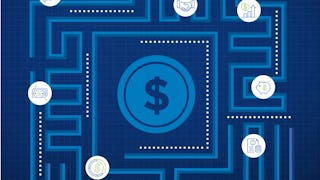In this course, you'll gain a strategic introduction to credit analysis and fixed income investing, blending foundational principles with practical tools to assess financial health, creditworthiness, and investment potential. Designed for professionals in investment management, corporate finance, or credit evaluation, the course explores how credit decisions are made, how debt instruments function, and how financial and non-financial data inform risk assessment.



Recommended experience
What you'll learn
Execute comprehensive ratio analysis for credit evaluation using industry-standard metrics.
Perform advanced cash flow analysis to assess debt servicing capabilities.
Calculate probability of default and expected loss using quantitative models.
Apply structural and reduced-form credit risk models for investment decision-making.
Skills you'll gain
Details to know

Add to your LinkedIn profile
August 2025
5 assignments
See how employees at top companies are mastering in-demand skills

There are 6 modules in this course
In this course, you’ll learn how to conduct advanced financial analysis and build robust credit risk models used by professional analysts and institutional lenders. You’ll focus on techniques like ratio and cash flow analysis, probability of default estimation, expected loss modeling, and structural vs. reduced-form credit risk approaches. Through expert instruction and hands-on Excel labs, you’ll gain the skills to evaluate creditworthiness, forecast default scenarios, and support high-stakes lending and investment decisions with data-driven insights. This course will equip you to move from foundational analysis to enterprise-grade credit risk modeling that drives real-world financial performance.
What's included
1 reading
In this module, you’ll learn how to evaluate credit risk through comprehensive ratio analysis, using liquidity, leverage, and profitability metrics to assess financial health and debt servicing ability. You’ll examine the practical application of ratios in real-world credit assessments and explore common pitfalls to avoid misinterpretation. Through expert-led sessions, hands-on Excel exercises, and an applied case study, you’ll gain the skills to interpret financial statements with precision and make informed credit evaluation decisions.
What's included
6 videos1 reading1 assignment1 peer review
In this module, you’ll learn how to assess a company’s debt servicing ability through advanced cash flow analysis techniques. You’ll explore the role of EBITDA, free cash flow, and liquidity metrics in evaluating creditworthiness, and apply stress testing and scenario analysis to gauge financial resilience under adverse conditions. Through expert instruction, Excel-based exercises, and case-driven applications, you’ll develop the skills to interpret and model cash flow data for robust credit risk analysis.
What's included
6 videos1 reading1 assignment1 peer review1 discussion prompt
In this module, you’ll explore the structure, methodologies, and real-world impact of credit ratings within financial markets. You’ll examine how major credit rating agencies assign ratings, how these ratings influence borrowing costs and capital access, and how they differ across sovereign and corporate entities. Through a detailed case study, hands-on analysis of an actual credit rating report, and critical evaluation of rating limitations, you’ll build the skills to interpret, apply, and question credit ratings in professional financial decision-making.
What's included
6 videos1 reading1 assignment1 peer review1 discussion prompt
In this module, you’ll examine the influence of macroeconomic factors on credit risk, focusing on how variables like inflation, interest rates, and economic cycles shape credit markets. You’ll explore sector-specific vulnerabilities, global risks, and the interplay between economic conditions and default probabilities. Through case studies and hands-on analysis using real data sources, you’ll learn to evaluate how shifting macroeconomic conditions impact credit quality and risk assessment strategies.
What's included
6 videos1 reading1 assignment1 peer review
In this module, you’ll analyze the distinctions between corporate and sovereign bonds, focusing on their respective risk factors, credit assessment methods, and market behavior. You’ll investigate how yield spreads signal default risk and economic confidence, and how factors like country risk, debt structure, and market sentiment shape investment decisions. Using real-world data and comparative case studies, you’ll learn to assess the creditworthiness of governments and corporations, and apply bond performance metrics to inform credit risk strategy and portfolio decisions.
What's included
6 videos1 reading1 assignment2 peer reviews
Earn a career certificate
Add this credential to your LinkedIn profile, resume, or CV. Share it on social media and in your performance review.
Instructors


Offered by
Explore more from Finance
 Status: Preview
Status: PreviewStarweaver
 Status: Preview
Status: PreviewCoursera Instructor Network
 Status: Preview
Status: PreviewCoursera Instructor Network
 Status: Free Trial
Status: Free TrialDuke University
Why people choose Coursera for their career





Open new doors with Coursera Plus
Unlimited access to 10,000+ world-class courses, hands-on projects, and job-ready certificate programs - all included in your subscription
Advance your career with an online degree
Earn a degree from world-class universities - 100% online
Join over 3,400 global companies that choose Coursera for Business
Upskill your employees to excel in the digital economy
Frequently asked questions
To access the course materials, assignments and to earn a Certificate, you will need to purchase the Certificate experience when you enroll in a course. You can try a Free Trial instead, or apply for Financial Aid. The course may offer 'Full Course, No Certificate' instead. This option lets you see all course materials, submit required assessments, and get a final grade. This also means that you will not be able to purchase a Certificate experience.
When you purchase a Certificate you get access to all course materials, including graded assignments. Upon completing the course, your electronic Certificate will be added to your Accomplishments page - from there, you can print your Certificate or add it to your LinkedIn profile.
You will be eligible for a full refund until two weeks after your payment date, or (for courses that have just launched) until two weeks after the first session of the course begins, whichever is later. You cannot receive a refund once you’ve earned a Course Certificate, even if you complete the course within the two-week refund period. See our full refund policy.
More questions
Financial aid available,


